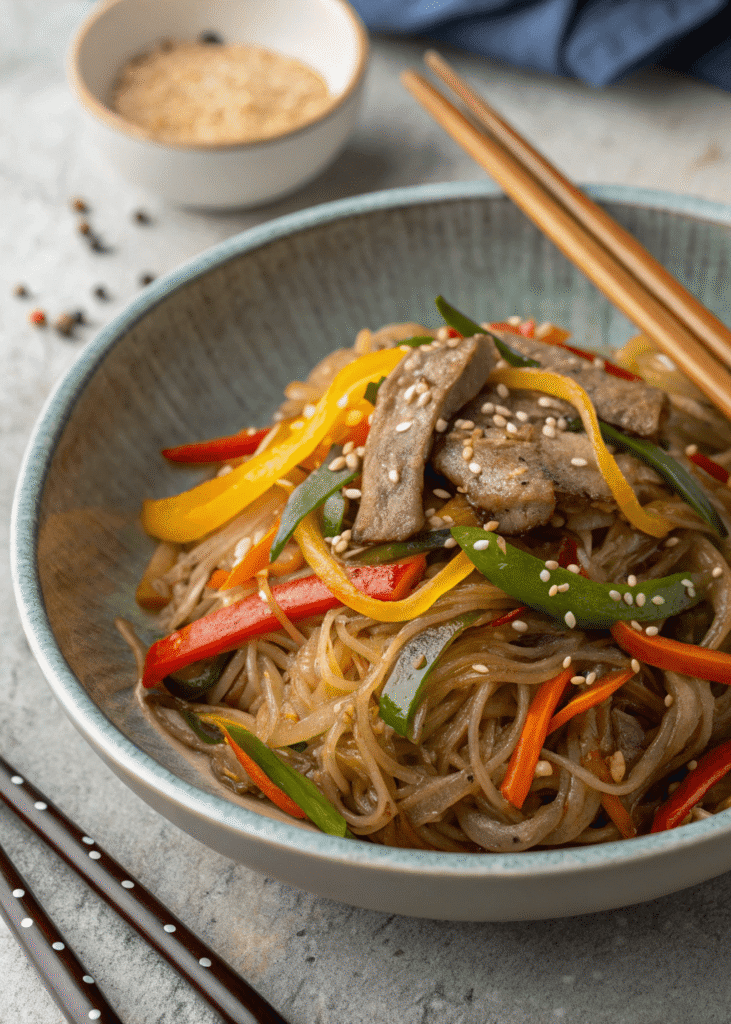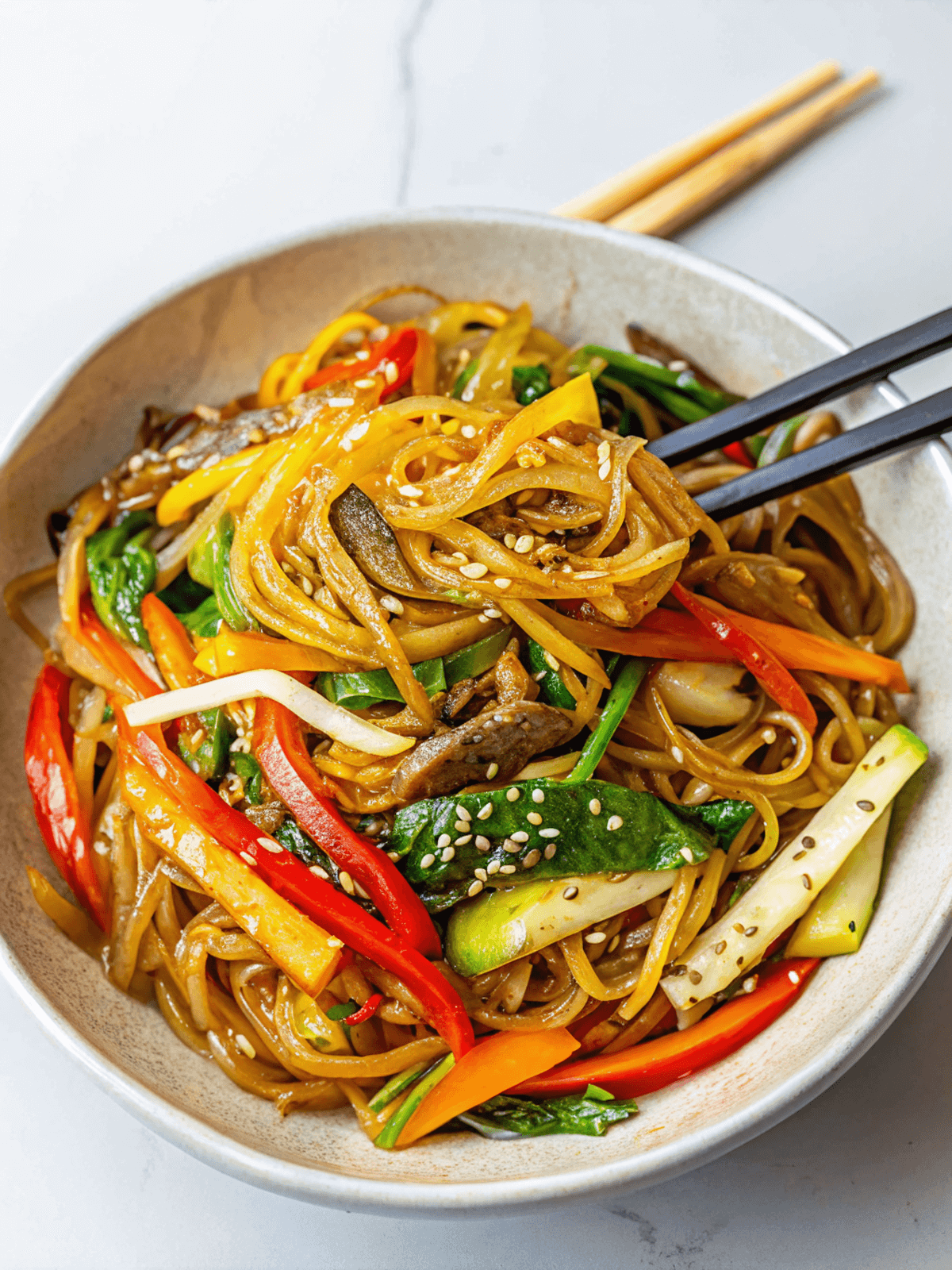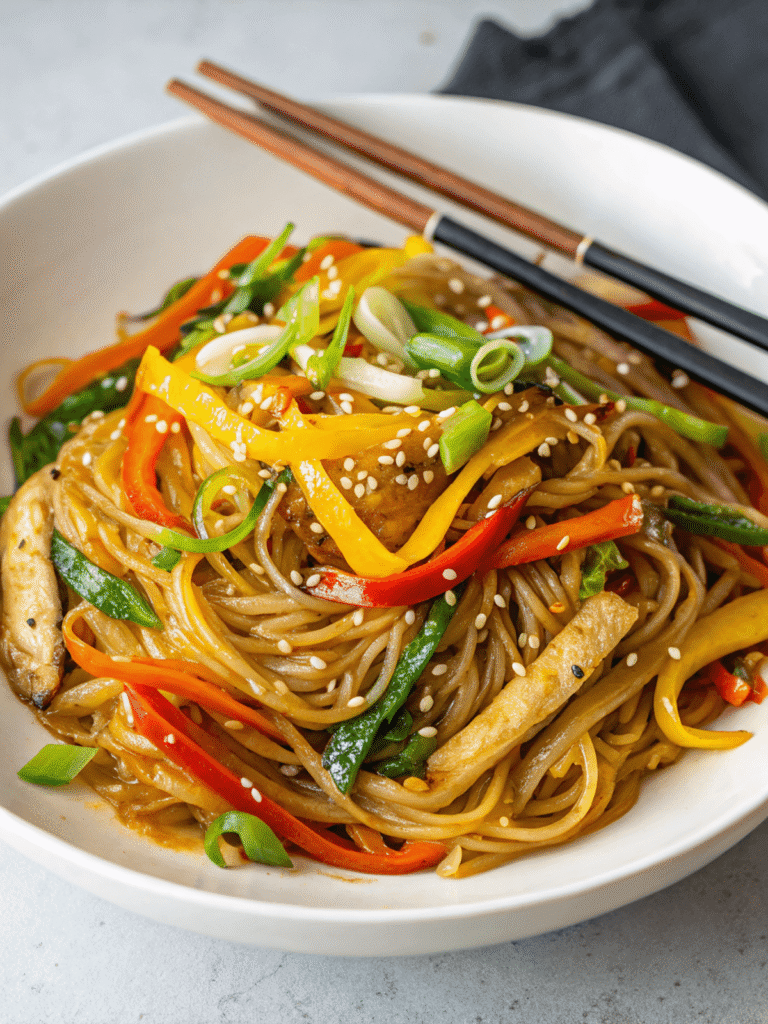Can a Quick Noodle Dish Really Deliver on Flavor and Nutrition?
Absolutely — and this Japchae recipe proves it. If you think fast meals mean sacrificing flavor, think again. Japchae, the beloved Korean glass noodle stir-fry, isn’t just easy and fast (25 minutes start to finish); it’s also deeply satisfying, healthy, and endlessly customizable. Popular among busy parents, this colorful noodle dish combines chewy glass noodles, a rich umami seasoning sauce, and crisp vegetables with a slightly sweet and savory twist. Plus, it’s a top-rated vegetarian japchae that even meat-lovers enjoy. You’ll quickly see why this Japchae recipe is a staple in Korean cuisine and the go-to comfort food for quick dinners.
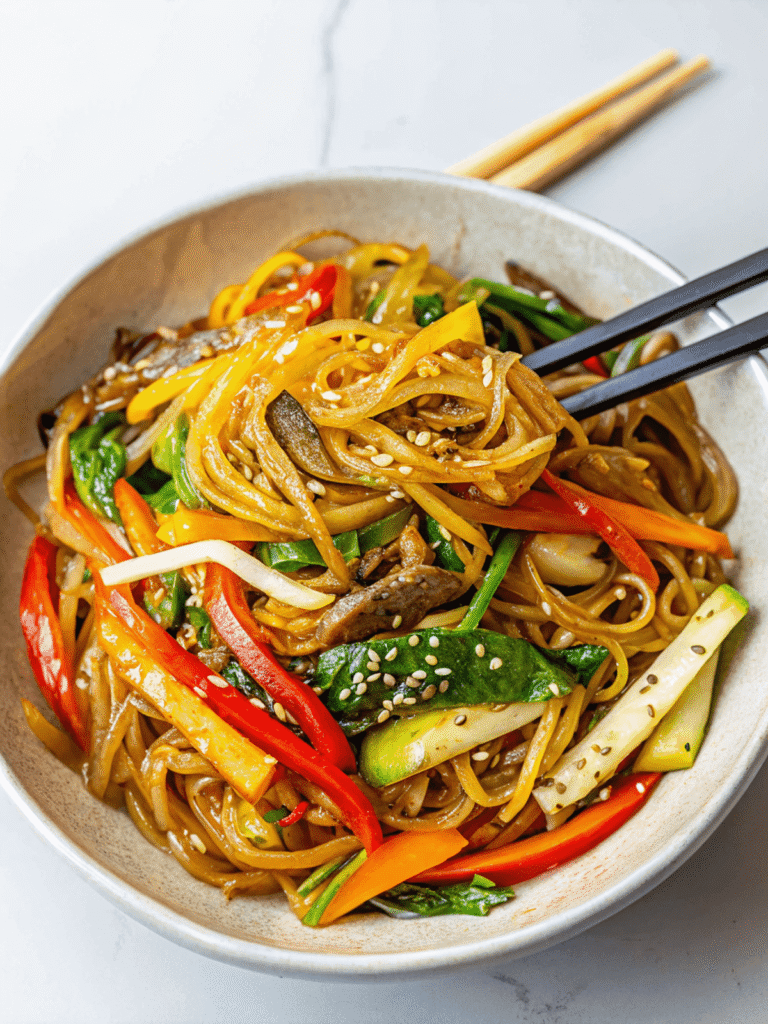
Ingredients List
Essential Ingredients:
- 8 oz sweet potato noodles (a.k.a. glass noodles or sweet potato starch noodles)
- 1 tbsp sesame oil (divided)
- 2 tbsp vegetable oil
- 1/2 cup shiitake mushrooms (or dried woodear mushrooms), thinly sliced
- 1 cup julienned carrots
- 1 cup spinach or bok choy
- 1/2 sweet onion, thinly sliced
- 2 green onions, sliced on bias
- 1/2 cup red bell pepper, thinly sliced
- 1 tbsp minced garlic
- 1 tsp white sugar
- 2 tbsp soy sauce or gluten-free soy sauce
- 1 tbsp brown rice syrup or maple syrup
- 1/2 tsp rice wine
- 1 tsp balsamic vinegar (for brightness)
- 1 tbsp sesame seeds or toasted sesame seeds
Optional Protein Add-ins:
- 1/2 cup cooked shabu-shabu beef, lean beef, or rib eye fillet
- 1/2 cup sliced pork loin or scotch fillet
- 1/2 cup sliced king oyster mushrooms for a vegan protein swap
- 1/4 cup cooked Just Egg for egg ribbons or egg garnish
Substitution Tip: Use vegetable broth to sauté for an oil-free version.
Timing
- Prep Time: 10 minutes
- Cook Time: 15 minutes
- Total Time: 25 minutes
This Japchae recipe clocks in 25 minutes — that’s 40% faster than most Korean noodle dish recipes, making it ideal for quick weeknight cooking or weekend meal prep. Thanks to its minimal prep and high flavor payoff, this Japchae recipe is perfect for families looking to serve a crowd-pleasing dish in under half an hour.
Step-by-Step Instructions
Step 1: Soak and Boil the Glass Noodles
- Soak glass noodles in cold water for 10 minutes.
- Boil for 5-6 minutes until bouncy and clear. Drain, rinse with cold water, and cut with kitchen scissors if too long.
Step 2: Prep the Seasoning Sauce
- In a small bowl, mix soy sauce, brown rice syrup, rice wine, balsamic vinegar, and a touch of sesame oil.
Step 3: Stir-Fry the Vegetables
- Heat vegetable oil in a large wok. Sauté sweet onion, carrots, and bell peppers until tender-crisp.
- Add shiitake mushrooms, green onion, and garlic cloves.
Step 4: Toss in Noodles and Sauce
- Add the drained sweet potato starch noodles and pour in your homemade seasoning sauce.
- Toss gently with tongs. Add more sesame oil and vegetable broth if needed.
- This step is where the Japchae recipe transforms into a true flavor bomb.
Step 5: Finish and Garnish
- Sprinkle with toasted sesame seeds and extra green onion.
- Serve warm or cold — perfect either way.

Nutritional Information (Per Serving)
- Calories: 310
- Protein: 6g
- Carbs: 52g
- Sugars: 8g
- Fiber: 3g
- Fat: 10g
- Saturated Fat: 1.5g
- Sodium: 620mg
Healthier Alternatives for the Recipe
- Swap soy sauce for gluten-free soy sauce to make it celiac-friendly.
- Use brown rice syrup instead of white sugar for a lower-glycemic index.
- Opt for king oyster mushrooms instead of beef or pork for a clean vegan twist.
- Add spiralized sweet potatoes for more fiber and sweetness.
- Replace cooking oil with a splash of vegetable broth to lower fat content.
Serving Suggestions
- Pair with kimchi udon stir fry for a double noodle night.
- Serve with korean pancakes or alongside kimchi guksu.
- Add an egg for a classic egg garnish or serve with pickled radish for crunch.
- Try cold with cucumber slices and extra balsamic vinegar for summer meals.

Common Mistakes to Avoid
- Overcooking glass noodles — they become mushy fast.
- Skipping sesame oil — it’s key to the signature flavor.
- Undermixing sauce — the balance of sweet, salty, and savory must blend fully.
- Not rinsing noodles — keeps texture bouncy and prevents clumping.
- Leaving out sesame seeds — they add nutty crunch that completes the dish.
Storing Tips for the Recipe
- Store leftovers in an airtight container in the fridge for up to 4 days.
- Reheat with a splash of vegetable broth to restore moisture.
- Japchae also freezes well — divide into portions and thaw overnight.
- Best served warm but excellent as a cold lunch option.
Conclusion
This Japchae recipe makes Korean cuisine accessible, quick, and delicious for the modern home cook. In just 25 minutes, you get colorful, flavorful, family-approved comfort food. It’s the go-to vegetarian japchae that doesn’t sacrifice taste or time. No wonder so many busy parents rely on this Japchae recipe as their .
Try this japchae recipe today, leave a comment, rate it below, and subscribe for more easy wins in the kitchen.
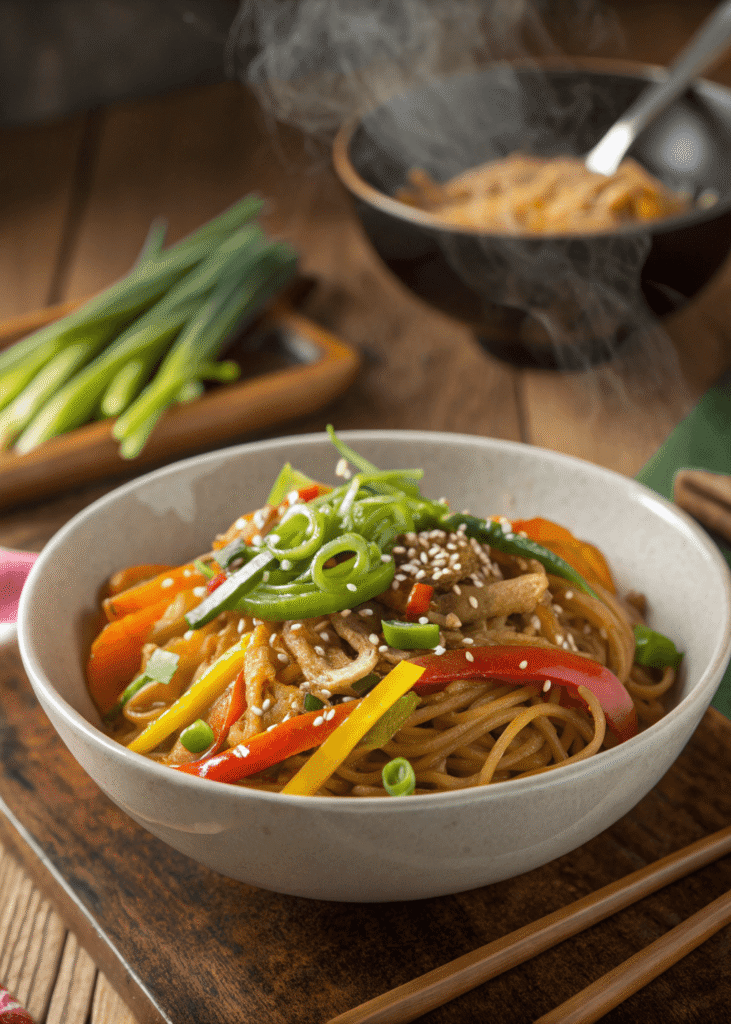
FAQs
Can I use other noodles besides sweet potato noodles?
You can, but for authenticity and texture, sweet potato starch noodles are best.
Is japchae always vegetarian?
Traditional japchae often includes marinated meat, but this version is a flavorful vegetarian japchae.
Can I make japchae ahead of time?
Yes! It holds up great for meal prep and tastes amazing cold or reheated.
What’s the history of japchae?
It dates back to the Joseon Dynasty, reportedly made for King Gwanghaegun by his courtier Yi Chung during a royal harvest festival.
What should I serve with japchae?
Try it with korean pancakes, kimchi udon stir fry, or as part of Korean celebrations and holidays.
